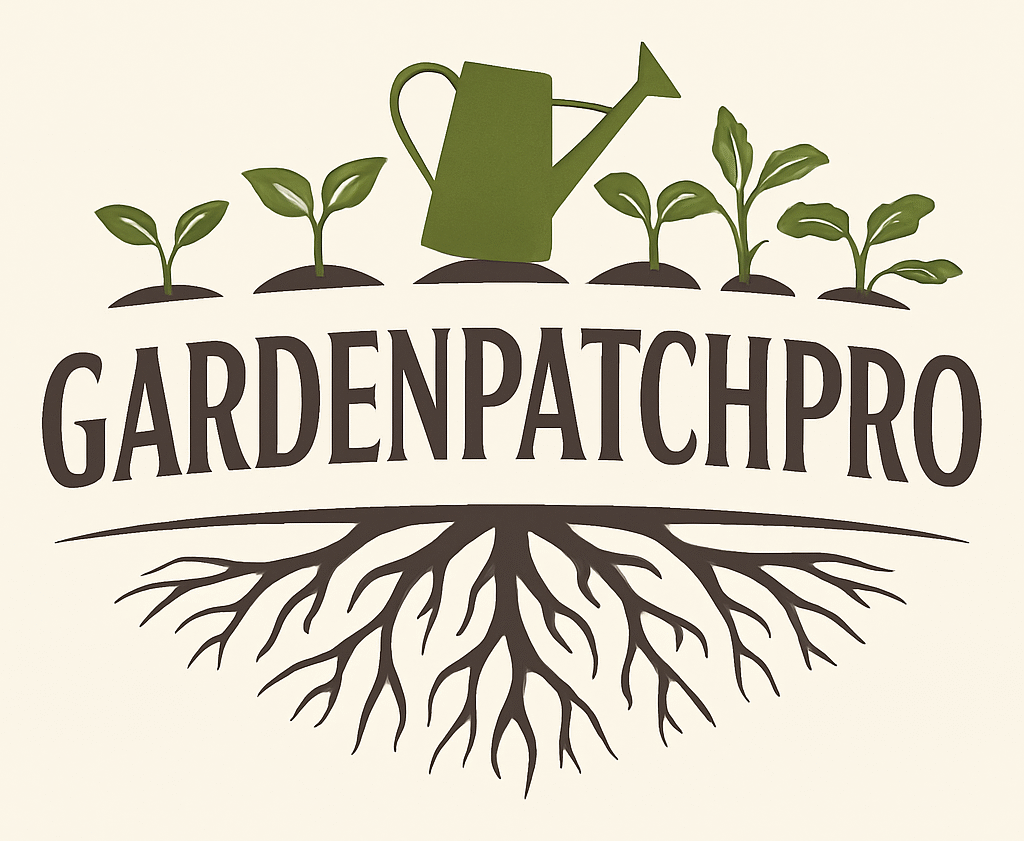9 Ornamental Grasses for Low-Maintenance and Stylish Gardens
Ornamental grasses have become a popular choice for gardeners and landscapers. They add texture, color, and movement to outdoor spaces, enhancing the overall look without needing much maintenance. These grasses can fit many different garden styles and climates.

They provide visual interest year-round and can thrive in a variety of conditions, making them practical and attractive plants for many landscapes. Understanding the different types helps people choose the best grasses for their specific needs and environments.
1) Miscanthus sinensis (Maiden Grass)
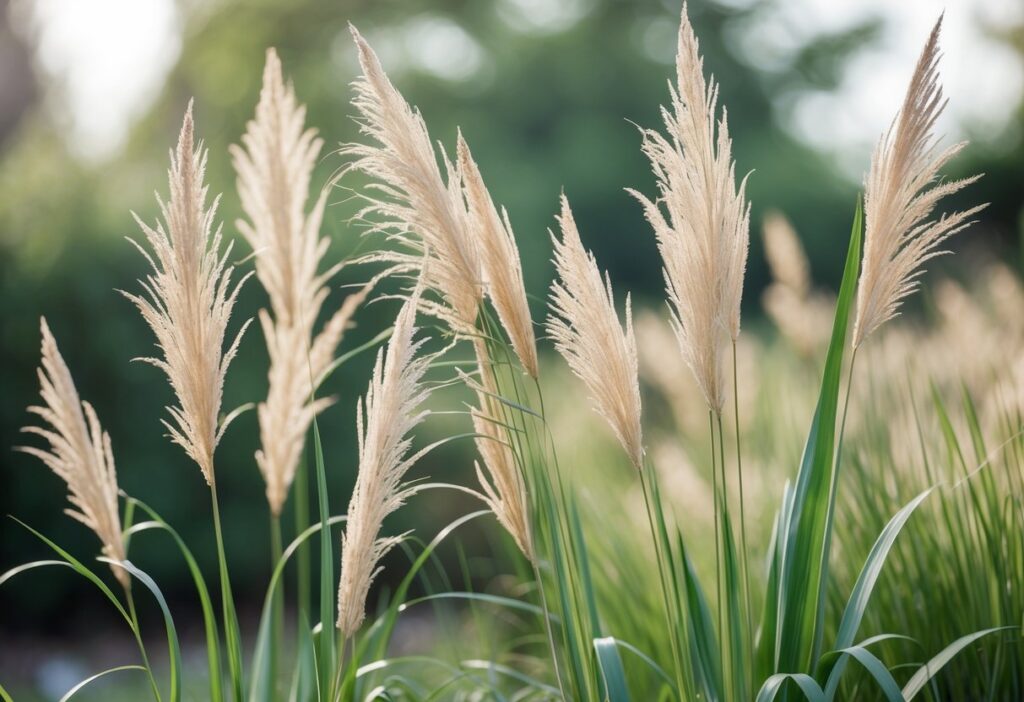
Miscanthus sinensis, commonly called Maiden Grass, is a tall ornamental grass that grows 6 to 8 feet high. It has slender, arching leaves with a fine texture. The blades start silver-green and turn golden-bronze after the first frost.
This grass produces feathery plumes in late summer that can last into winter. The plumes add texture and interest to gardens during the colder months. Maiden Grass works well in borders, beds, and as a screen.
It is native to parts of Asia, including China, Japan, and Korea. Maiden Grass grows best in USDA zones 4 to 9. It is hardy and fairly easy to care for, needing full sun and well-drained soil.
The plant spreads in clumps, which can fill in space over time. Gardeners value it for its multi-seasonal appeal and low maintenance. More details about growing Maiden Grass can be found at Monrovia’s Maiden Grass page.
2) Panicum virgatum (Switchgrass)
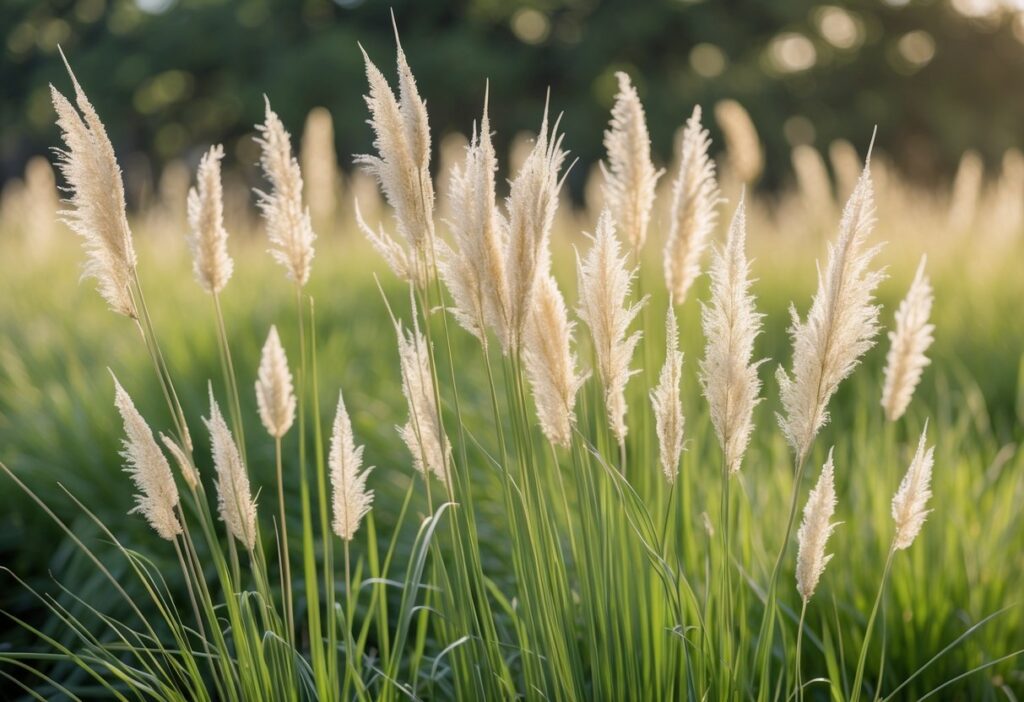
Panicum virgatum, commonly called switchgrass, is a native grass found across North America. It grows in clumps and can reach heights of 3 to 8 feet, making it one of the taller ornamental grasses.
It has narrow, blade-like leaves that range in color from olive green to blue-green. In mid to late summer, it produces airy flower panicles that add texture above the foliage.
Switchgrass is adaptable to many soil types, from dry to moist conditions. It grows best in full sun but can tolerate some shade. It is low maintenance and drought tolerant.
The foliage turns golden or yellow in the fall, providing color well into autumn. Sturdy stems hold their shape through winter, offering year-round structure in the landscape.
Cultivars like ‘Cloud Nine’ stand out for their erect form and blue-green leaves topped with fine, airy flowers. Switchgrass also helps control erosion and supports wildlife by providing shelter for birds during winter.
Learn more about switchgrass’s characteristics and care at this Switchgrass growing guide.
3) Festuca glauca (Blue Fescue)
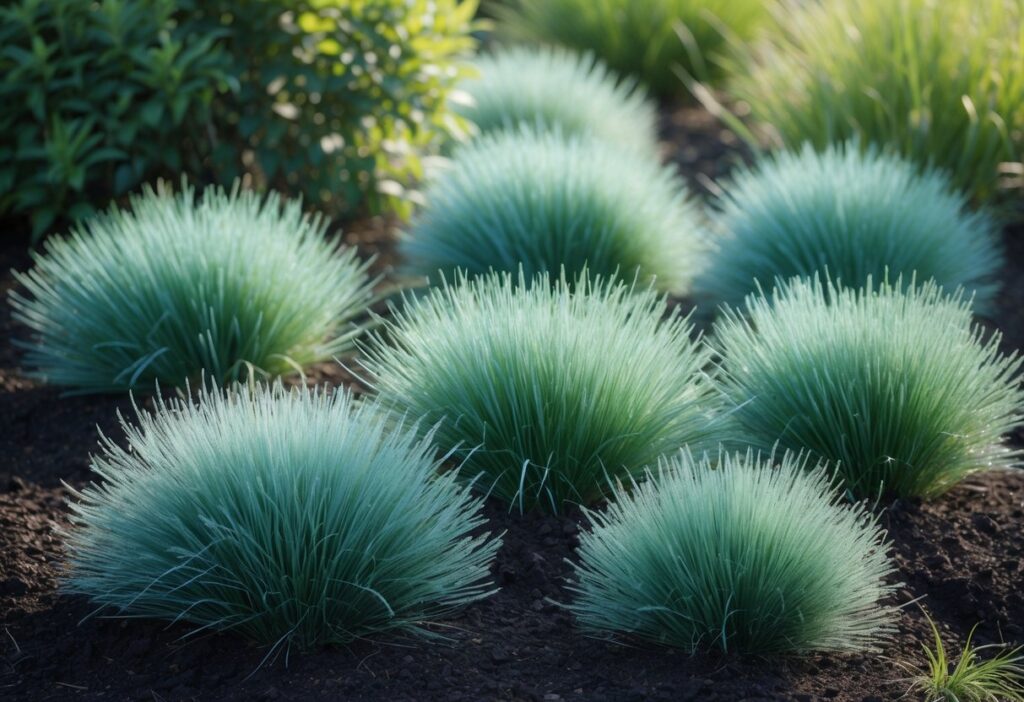
Festuca glauca, commonly called Blue Fescue, is a small, clump-forming ornamental grass. It has fine, needle-like leaves with a striking blue-gray color that adds a cool tone to gardens. This color stays vibrant through most of the year.
It grows slowly into compact mounds that reach about 6 to 8 inches tall. The plant produces soft, pale green flowers that turn buff-colored as they age. These flower stalks appear in summer and add light texture.
Blue Fescue is drought tolerant and thrives in well-drained soil. It grows well in USDA zones 4 to 8. Its low water needs make it a good choice for rock gardens, borders, and containers.
This grass works well as an accent or companion plant. It pairs nicely with more colorful or larger plants because of its unique color and fine texture. It requires little maintenance to stay healthy and attractive.
More details about Blue Fescue’s growth and care can be found on The Spruce.
4) Pennisetum alopecuroides (Fountain Grass)
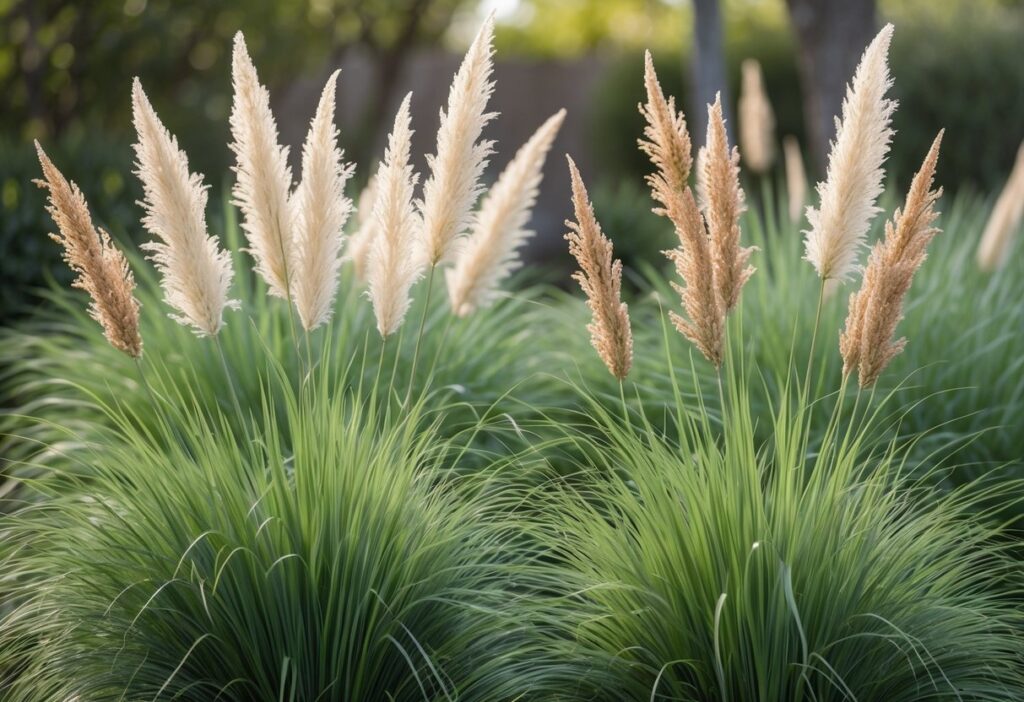
Pennisetum alopecuroides, commonly called Fountain Grass, is a popular ornamental grass known for its graceful, arching form. It typically grows in rounded clumps reaching 2 to 4 feet tall and wide.
The grass has narrow, medium green leaves that turn golden yellow or beige in the fall. It produces soft, bottlebrush-like flower spikes that add texture and color late in the season.
Fountain Grass is native to East Asia and prefers full sun. It is a warm-season grass that is fairly cold-hardy and needs little care once established.
Its elegant foliage creates gentle movement in the wind. This makes it a good choice for borders, mass plantings, or as a focal point in the garden.
Different varieties exist, including some with colorful plumes like the red-flowered Ginger Love. Overall, it is valued for its steady growth and year-round interest. For more details on its care and varieties, see this Fountain Grass guide.
5) Calamagrostis x acutiflora (Feather Reed Grass)
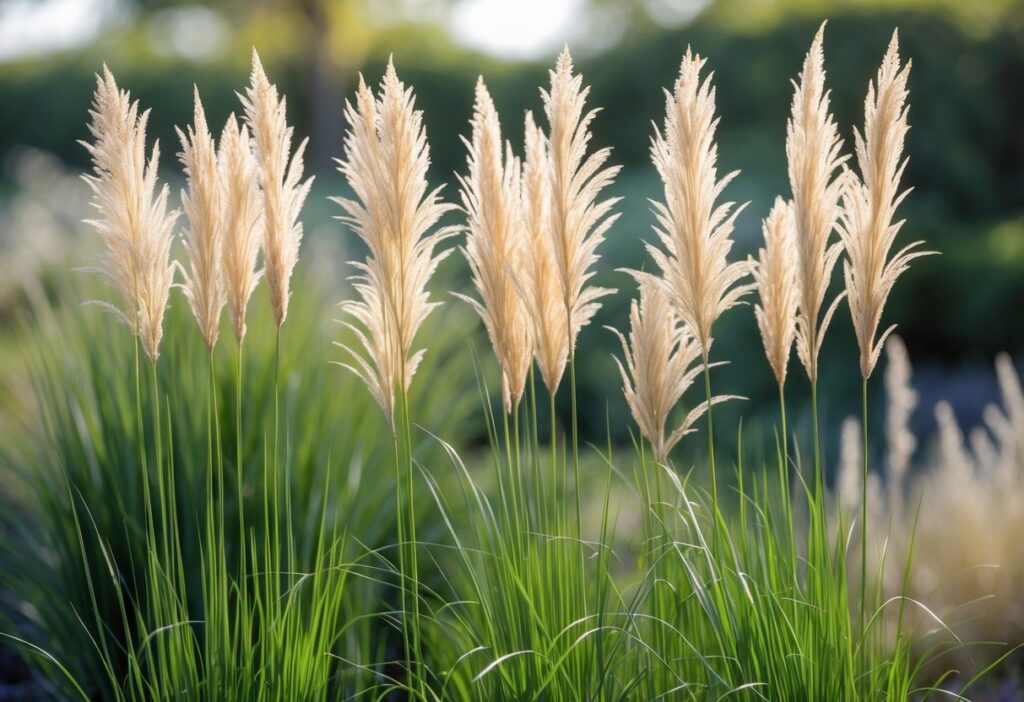
Calamagrostis x acutiflora, commonly called Feather Reed Grass, is a popular ornamental grass known for its upright, narrow form. It grows in neat clumps and adds vertical interest to gardens.
This grass is a hybrid from species native to Europe and Asia. It adapts well to different conditions, from wet soils to dry areas. It is also one of the first grasses to show green leaves in early spring.
The most common cultivar is ‘Karl Foerster.’ It has tall, feathery flower spikes that start reddish-brown in spring and turn golden in fall. These stalks stay upright even in winter, giving year-round structure.
Feather Reed Grass requires low maintenance. It grows best in full sun but tolerates partial shade. It is widely used in mass plantings, borders, and as a vertical accent in mixed beds.
For details on care and plant traits, see how to grow Feather Reed Grass.
6) Carex oshimensis (Japanese Sedge)

Carex oshimensis, known as Japanese Sedge, is a popular ornamental grass. It features narrow, arching leaves with creamy yellow centers and dark green edges. The foliage forms a soft, fountain-like shape, adding texture to gardens.
This plant grows to about 12-18 inches tall. It prefers dry to average soil moisture, unlike many other sedges. It is evergreen in mild climates and provides year-round interest.
Japanese Sedge is low-maintenance and adapts well to various light conditions. It tolerates shade and part sun, making it suitable for many garden spots. It also resists pests and deer, which helps keep it healthy.
Carex oshimensis is often used as ground cover, in borders, or in containers. It’s valued for its compact size and bright foliage, which brightens up shady areas. For more details, see this page on variegated Japanese Sedge.
7) Schizachyrium scoparium (Little Bluestem)

Schizachyrium scoparium, known as Little Bluestem, is a native North American grass. It grows in many types of habitats, from dry hills to open woods. This grass forms narrow, upright clumps that reach 2 to 4 feet tall.
Little Bluestem has blue-green leaves in summer that turn reddish-bronze in fall. It provides long-lasting color and texture in gardens and natural landscapes. The grass also produces tufted seed heads that add winter interest.
It is drought-tolerant and thrives in average to dry soil conditions. Little Bluestem needs low care and adapts well to different environments. These qualities make it a popular choice for prairie restoration and ornamental borders.
This grass fits well in sunny locations and supports wildlife. Its deep roots help prevent soil erosion and improve soil health. Little Bluestem is a practical and attractive option for gardeners seeking a native, low-maintenance grass.
Learn more about growing Little Bluestem from the Missouri Botanical Garden.
8) Muhlenbergia capillaris (Pink Muhly Grass)
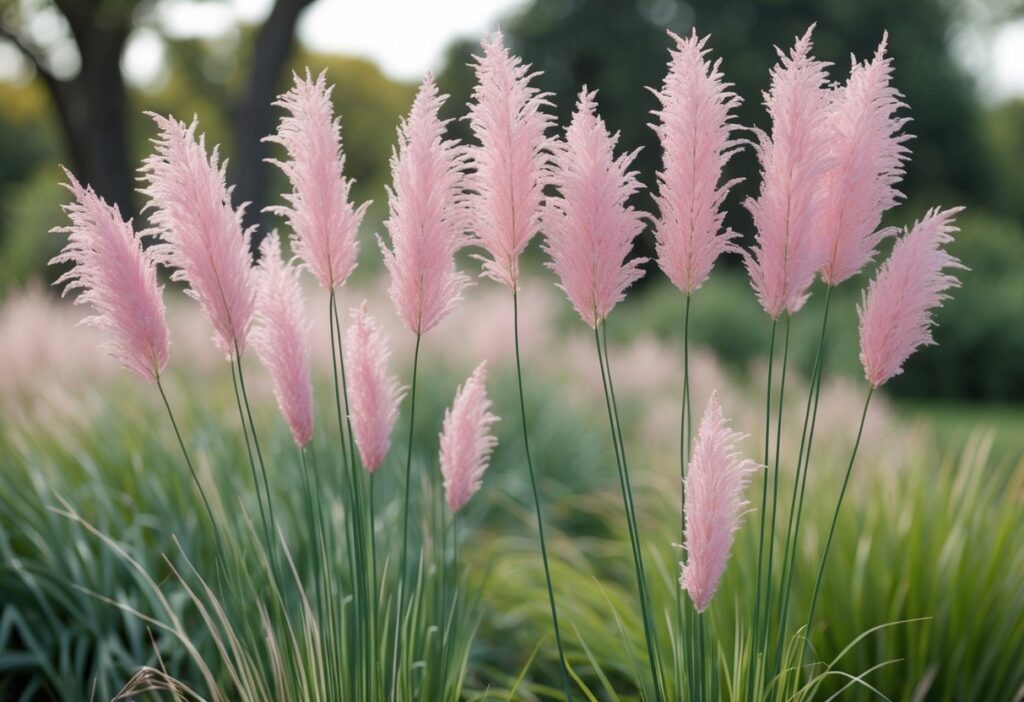
Muhlenbergia capillaris, known as Pink Muhly Grass, is a perennial ornamental grass. It grows well in full sun and prefers well-drained soil. This grass typically reaches about 3 feet tall.
Its most notable feature is the airy plumes of pink flowers that appear in late summer through fall. These vibrant blooms create a soft, cloud-like effect in gardens.
Pink Muhly Grass is native to the southeastern United States but can be grown in many regions. It is low-maintenance and tolerant of drought once established.
This grass resists deer and has few problems with pests or diseases. Its fine-textured, dark green leaves contrast well with the bright flower plumes.
Because of its striking appearance and easy care, it is often used in landscape designs for borders and mass plantings. The plant adds color and texture without needing much attention.
Learn more about how to grow and care for Pink Muhly Grass on The Spruce.
9) Stipa tenuissima (Mexican Feather Grass)

Stipa tenuissima, also known as Mexican Feather Grass, is a fine-textured ornamental grass. It has slender, soft green leaves that move gently with the wind, creating a graceful look in gardens.
This grass grows in dense clumps and reaches about 2 to 3 feet tall. It produces silvery, hairlike seed heads that turn golden in the fall.
Mexican Feather Grass prefers full sun and dry soil. It is drought tolerant and works well in containers or landscape beds.
Though delicate in appearance, it is surprisingly tough and can spread by self-seeding. This spread can be aggressive in some areas, so care is advised during planting.
It adds texture and movement to any garden, making it a popular choice for ornamental planting. More details about its care and features are available at Gardenia and Proven Winners.
Design Tips for Ornamental Grasses

Ornamental grasses add texture and movement to any landscape. To use them well, it is important to focus on how they catch the eye, how they work with other plants, and how they fit into the edges of garden spaces.
Creating Visual Interest
To create visual interest, use grasses of different heights and forms. Taller grasses like feather reed grass add vertical movement. Shorter types provide groundcover or mid-level texture.
Textures also matter. Using grasses with fine blades next to those with broad leaves creates contrast. Color changes through seasons add another layer of interest, so pick grasses that vary from green to gold or red.
Grouping odd numbers, like three or five clumps, can make the arrangement feel natural and balanced. Moving plants slightly with the breeze adds life to the garden.
Pairing with Perennials
Pairing ornamental grasses with flowering perennials can enhance both. Coarse-textured grasses like maiden grass look good next to soft, fine-leaved plants such as lavender or sedum.
Choose perennials that bloom at different times than the grasses’ peak to keep the garden lively all year. For example, combine late-blooming flowers with grasses that show strong fall color.
Grasses help fill space when perennials die back, maintaining garden shape through winter. This pairing also helps with pest control and water efficiency.
Incorporating in Borders
Ornamental grasses work well in borders due to their structure and low maintenance. Place them in front of taller shrubs or where they can form soft edges along paths.
When using grasses in borders, avoid crowding. Provide enough room for growth—most need around 2 to 3 feet of space. This prevents plants from looking messy or getting diseased.
Choose species with slow spread or clumping habits to keep borders neat. Mixing upright and arching grasses can guide the eye along the border and add flow.
For more ideas on design with ornamental grasses, see designing with grasses tips.
Care and Maintenance Essentials

Ornamental grasses thrive with specific care actions that keep them healthy and attractive year-round. Proper watering, soil attention, trimming, and pest control work together to support growth and appearance. Simple routine steps help these grasses stay strong and vibrant in most garden settings.
Watering and Soil Requirements
Ornamental grasses need well-drained soil to prevent root rot. They grow best in soil that allows water to flow through easily without staying soggy. Most types prefer full sun but tolerate some light shade.
During the first growing season, consistent watering is key to establish strong roots. After that, many grasses are drought-tolerant and require less frequent watering. It is best to water deeply but infrequently to encourage deep root growth.
Adding organic matter to the soil improves its texture and drainage. Mulching around the base helps keep roots cool and retains moisture during hot weather. Avoid overwatering since it can lead to weak plants and disease.
Trimming and Pruning
Cutting back ornamental grasses is important for their renewal. This usually happens in early spring before new shoots emerge. Using sharp shears, grasses should be trimmed down to about 4-6 inches above the ground.
Pruning removes old, dead foliage, making way for fresh growth. It also tidies the garden by preventing grasses from becoming messy or overcrowded.
Dividing the plants every few years is necessary if they become too dense. This is done in the spring when soil is workable. Dividing promotes healthier growth and expands the number of plants available.
Pest and Disease Management
Ornamental grasses face few pest issues, but occasional problems can occur. Common pests include aphids, spider mites, and grasshoppers. Regular inspection helps catch infestations early.
Using insecticidal soap or natural predators controls most pests effectively. Maintaining proper spacing prevents humidity buildup, lowering disease risk.
Fungal infections like rust or leaf spot may appear in damp conditions. Removing affected leaves and ensuring good air circulation helps limit spread. Disease occurrence is rare with proper watering and care habits.
Frequently Asked Questions
Ornamental grasses vary in their care needs, sunlight preferences, and sizes. Some are better for dry conditions, while others do well in partial shade. Certain tall grasses can add height to a garden, and some types require specific pruning practices.
What are some low-maintenance ornamental grasses?
Festuca glauca (Blue Fescue) and Pennisetum alopecuroides (Fountain Grass) are known for being low-maintenance. They require minimal watering once established and do not need frequent cutting back.
Can you list drought-tolerant ornamental grasses suitable for landscaping?
Miscanthus sinensis (Maiden Grass) and Panicum virgatum (Switchgrass) are drought-tolerant when mature. They handle dry conditions well after the first growing season and fit landscaping that requires less irrigation.
What ornamental grasses thrive in full sun in Zone 9?
Miscanthus sinensis (Maiden Grass), Panicum virgatum (Switchgrass), and Calamagrostis x acutiflora (Feather Reed Grass) thrive in full sun and warm climates like Zone 9. These grasses grow vigorously and add texture to sunny gardens.
Which ornamental grasses can grow in part sun conditions?
Fountain Grass (Pennisetum alopecuroides) and Blue Fescue (Festuca glauca) perform well in partial sun. They adapt to spots that receive a mix of sun and shade, providing color and movement.
Are there any ornamental grasses that should not be cut back?
Some ornamental grasses should only be cut back at the end of winter or early spring. Cutting them too early can damage new growth. This applies to most popular types, including Maiden Grass and Fountain Grass.
What options are available for tall ornamental grasses reaching around 8 feet in height?
Miscanthus sinensis (Maiden Grass) and certain varieties of Switchgrass can grow to about 8 feet or taller. These are good choices when tall, vertical accents are needed in a landscape.
You can learn more about care and choices of ornamental grasses at Walters Gardens.
